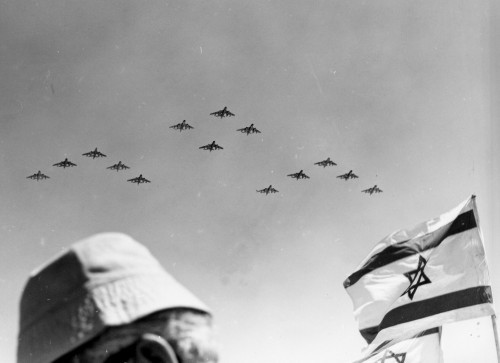
THE VAUTOUR IN THE IAF SERVICE

THE VAUTOUR IN THE IAF SERVICE
1. The IAF entered the campaign with 53 seviceable jet
fighters: 16 Mysteres (out of 61 purchased, because of shortage in trained pilots),
22 Ouragans and 15 Meteor fighters (including 3 T-7(R) and one NF-13).
The IAF also operated 46 Prop-Engined combat aircraft: 29 Mustangs,
15 Mosquitos and two B-17.
{This force was backuped by Mysteres (French and Israeli) and F-84Fs, with French crews}.
2. The need for long range fighter-bombers had postponed the withdrawl of the
Mosquitos. A small number was set back to activity { 13, in sqn. 110,
two P.R.16, together with 3 Meteors T.7(R) in the 115 sqn (PR) }.
3. The Mystere evinced superiority over the Mig-15 and the Ouragan
proved to be a stable platform in the close-support role.
The Mosquito had still his advantages, being the only type to supply long-range
reconnaissance and to perform long-endurance interdiction attacks.
4. The Mosquito ended its service a short time after the campaign,
all (except to 2 or 3 P.R.16) were withdrawn beginning of 1957.
5. Two of the lessons of "Kadesh",
(actually - these had bothered the IAF commanders already for some 2-3 years,
especially after the Czekh bargain with Egypt), were the urgent need for:
-> In other words - a jet replacement for the Mosquito, in his two proven
roles, plus the all-weather capability, which had never been practiced.
1. That period, end of 1956, the only available aircraft was the British "Canberra". this was a light bomber, produced in several versions, with a crew of 2-3 and equipped with two Rolls-Royce engines. But the Canberra was not a fighter-bomber, its defensive power was weak or none, and its payload not really impressive. It is to say that the "Canberra" had a good climb rate and high ceiling. The Americans (for the first time..) adopted this aircraft but upgraded it to the successful B-57, a bomber and subtypes - night intrusion, PR, and EW. But - there was no chance to purchase American "aggressive" weapons, because of USA policy regarding the Meaddle East conflict. 2. Just in time the genuine French Vautour appeared as the answer to the IAF different needs, embodied in one single design: a long-range fighter-bomber, a all-weather fighter and (as converted from a light bomber) a photo-recce bomber.
3. The purchase of the Vautour was subject to debates, hesitation and
political arguments. It demanded much convincing of the decision makers,
more than once, that the acquisition of the Vautour should gain
priority over cheaper alternatives (as buying
several tenths of A-26, a proposal that was seriously supported by
some seniors in the IAF), and also to stand against the "natural" wish for
fast jet fighters (as the Super Mystere, then in development). The credits
for the decision to insist on the Vautour belong to few, and mostly
to Yoash Tsiddon , deservedly called "the father of the Vautour" in
the IAF.
4. In retrospect few investments proved to be so profitable as the
acquisition of the Vautour.
5. The small amount purchased (originally 28, less
than any other fighting aircraft Israel ever bought), supplied the
IAF with a "long arm" and versatile element, to be proven in battle.

6. The next sections are an attempt to describe the Vautour's "voyage" in the IAF,
starting from its purchase (1957), through its fourteen years of service and ending
in its inevitable retirement (1971-1972).
 |
PURCHASE |
|---|